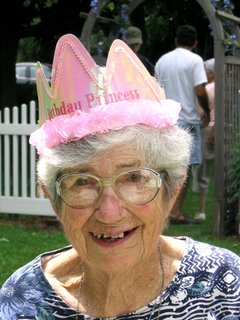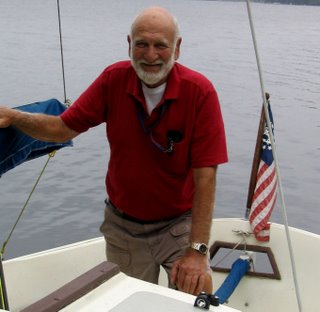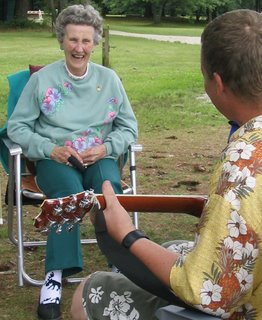Coming Attraction: A 119-year-old Stand-up Comic Making Them Roll in the Aisles.
To an audience used to fresh-faced sprigs as young as springtime, this guy is not just old. He's old old old. He is older than anyone in the audience has ever heard of. He is older than any human being could possibly be without being comatose in bed, unable to eat, hear, speak and sustained by tubes and beeping monitors.
He is 119. But instead of creeping on stage all bent over with decrepitude, he bounds on with the same zest as the young comics before him. As the headliner everybody has been waiting for, he is greeted by exuberant applause.
Over the past 19 years, since appearing on television on the occasion of his 100th birthday and exhibiting a vitality remarkable for his years and cracking joke after joke, he has become something of a celebrity.
But he has not forgotten where he came from. He is appearing in his home town. Grabbing the mike, he says, “Hi! Great to be back home among friends. Actually, it's great to be anywhere.”
The hackneyed line, a standard for aging comedians everywhere, gets him whoops and hollers. He doesn't even have to say, “at my age.” The audience is totally tuned into his shtick.
When the noise dies down, he says, “The wife and I just moved out of the old homestead into something smaller. We waited until the children were all dead.”
Laughter erupts all over again. With a devilish grin, he primes the audience for more. He holds back, playing, teasing. And when they can't wait another second, he hits them again.
“And, wouldn't you know, a few weeks later I buried my wife. Had to. Dead, you know.”
The room goes wild.
“I went to the doctor the other day and she gave me, three months to live. Great, I said. My life expectancy is four days.”
Now the laughter is nonstop.
“I'm tired of being widowed. Now that I'm single again and back dating, I'm looking for a wife I won't outlive – say a nice stacked 19-year-old chick with great legs.”
He puts a hand across the top of his forehead and peers out at the audience. “I see a lot great legs out there. What are you girls trying to do, overstimulate me to death?”
By the time he finishes his routine, there are smiles on every face.
A 119-year-old making jokes about old age and death? Well maybe not quite yet, because this frisky 119-year-old comic doesn't exist. Not yet, that is. But given accelerating medical advances and changing attitudes about age, such a scene may not be far-fetched within a generation or two.
People 85 and older are the fastest growing age group in America. The U.S. Census Bureau estimates that by 2050, the number of people 85 and older will jump to 19 million, from about 4 million today.
The second fastest growing age group? People 100 and over.
Mary Haines is shown here at her 90th birthday party. She is an athlete, a runner, who has been picked to light the Olympic torch for the 2009 National Senior Games if they are held in Connecticut where she lives. In a recent two-mile race – her first as a 90 year-old – the course turned out to be hillier and tougher than she expected.

Running alongside her daughter, Marybeth, 59, she kept a steady stride but began to falter toward the top of the steepest hill.
“I'm going to walk a bit,” she said to Marybeth.
Just then a race volunteer said, “You're almost there, only a third of a mile to go.”
She immediately picked up her pace and was running strong entering the downtown area where a large crowd had gathered to cheer her on. Fifty yards from the finish line, Marybeth said to her Mom, “This is the time to sprint.”
“I am sprinting,” the 90-year-old said, panting.
At the finish line, Mary Haines was met by a concerned EMT team. The team took her blood pressure. It was 106/60. Three nurses and a doctor in the medical tent were amazed at her blood pressure after running for two miles, much of it uphill.
“What is the name of your physician?” asked the nurse filling out forms.
“I don't have a physician,” Mary Haines replied.
“Maybe that's why she's so healthy,” quipped the doctor.
“Which medications are you on?” continued the nurse.
“I don't take any medications,” Mary Haines said.
Having turned 90 in good health, though her eyesight is beginning to fail, Mary Haines is already setting new goals and looking forward to the big One Oh Oh. She assumes that she will get there.
Larry Behr, who recently turned 80, does not seem to realize that he is no longer young. Considering that he still does everything he has always done, why should he? He is pictured preparing for a solo sail on Gardner Lake in Connecticut where he and his 68-year-old companion,
 Elaine Duval, camp in the summer.
Elaine Duval, camp in the summer.The couple travel, entertain, enjoy Ms. Duval's five children and sixteen grandchildren, and are so busy they don't have time to do everything they want to do. They are also careful what they eat and attribute much of their good health to the many dietary supplements that both take. Ms. Duval is a breast cancer survivor.
She is also someone who takes charge of her health. In the process of a heart attack, a mastectomy, chemotherapy, and breast reconstruction, she began reading voraciously about health. She became an informed and feisty patient.
When her doctor insisted that she go on tamoxifen, a drug widely given to post-menstrual cancer patients to try to prevent cancer recurrence, she refused. The doctor told her that in that case he could not do anything else for her. She found another doctor, not to mention robust health, not to mention love in the person of the young Mr. Behr. They are pictured here.
Another fellow old in years alone – he just turned 90 -- is the longtime fitness guru, Jack LaLanne, shown below. He has loftier ambitions than merely making it to 100. “I'm going to live to a hundred and fifty,” he told guests at his 90th birthday party.
He expects to live to 150 by doing what he has always been doing and which he preached in his long-running – from 1954 to 1984 -- fitness TV show: exercising and eating healthy.

Mr. LaLanne rises at 5. A.M. and works out in his home gym for an hour, using different machines and weights for abs, pecs, and every other important muscle group. Then he swims, vigorously, for an hour. He says that swimming is the best all-around exercise for the body, but “only if you swim against the clock.”
He says that three days a week working out is enough to keep in shape so long as it is vigorous. “I work out hard one day and rest the next,” he says.
He says that “everything is about circulation.” Good circulation is what determines how you look, from your skin to your hair, and how you feel and how much you can do, he says. “The best way to hurt your body is not to use it. Your body is your slave and it will do what you want it to do. But if you don't do anything with it, it goes to pot.”
He points out that “young people in their sixties, seventies, and eighties get sick and die " mainly because they don't exercise.” In addition, he says, millions of Americans start their day off with a coffee, donut, and cigarette. “Then they fall apart and wonder why.”
Mr. LaLanne heaps scorn on diets as nothing more than scams and money-making schemes. He keeps trim by getting all his protein from fish and egg whites, eating five or six daily helping of fruits and ten helpings of raw vegetables, as well as some 40 natural supplements.
He eats no meat. “Anything that comes from a cow, I don't eat,” he says. “It isn't what you do once in a while that is the problem; it's what you do all the time.”
At his 90th birthday party, he passed on the cake. He was busy dancing with his wife of sixty-plus years and also with women a third his age. He told everybody who would listen that he didn't feel anywhere near 90.
“I feel great!”
Celia Lucas, shown being serenaded at her 85th birthday celebration at a lakeside in Brimfield, Massachusetts, is another one whose life belies her years. Ms. Lucas has no health problems. But she did say that the index finger on her right hand was “killing her” and she was going to “have it taken care of.”

She still lives at the same Worcester, Mass. three-decker that her family has owned for decades. She laughs a lot and her jokes are usually at her own expense.
She has lots of friends and family in her life. However, she cherishes her independence. She goes on frequent cruises and bus trips – she had recently returned from an Alaska cruise – and says she is “having the time of my life.”
She says that many of her women friends are looking for a man, but that she isn't. “What do I want a man for?,” she asks. “I already took care of my husband until he died. I don't need to nurse anyone else, no way.”
The number of people reaching the magic milestone of 100 is soaring. In 2002, the U.S Census Bureau counted 58,684 centenarians in the U.S. The Bureau estimates that this number will rise to 1,095,000 by 2050 and could reach as high as 1,634,000. The super old are going to be everywhere. Four out of five will be women.
Among them will be amazing specimens of longevity who will be a lot older than a mere century. Of the planet's six billion human beings today, perhaps a thousand are 110 years old. But demographers are looking ahead to a day in a few generations when it will be common for people to be so old that they will view 100-year-olds as kids.
Increasing longevity has been a boon to the life insurance industry. For decades it has meant windfall profits for the industry. Life insurers make money when people keep on living, keep on paying premiums, and keep on putting off policy payoffs. With these things happening in spades but with premiums still based on 1980 mortality tables -- when Americans commonly died in their fifties and sixties-- the profits of the life insurance industry have been enormous.
Grudgingly, the life insurance industry has acknowledged the longevity trend. In new mortality actuarial tables, the industry has raised the bar from 100 to 120. Actuarial experts say that the change is long overdue.
Based upon simple demographic trends, then, some of the ultimate marathoners among us could be 119 some day and giving them a stand-up routine in L.A. For those of us harboring secret ambitions about becoming late, late, late-blooming comedic stars—proof positive of having escaped the ravages of senescence—the demographic message is unmistakeable: go for it.
So long and keep moving.
NOTE: My novel, State Kid: Hero of Literacy is now available on Amazon and for the Nook.
Billy Stone was a foster child.
He ran away from abuse.
He went to juvenile prison.
He went up from there.
And he did it his way.
With the power of the written word.
Amazon E-Books by George Pollock
A Beautiful Story
A Long, Happy, Healthy Life
I, Cadaver
Killers
State Kid
Unlove Story
Labels: aging longevity "social connections" "life expectancy", centenarians, life expectancy, old age, old and healthy, super old age, the healthy old




